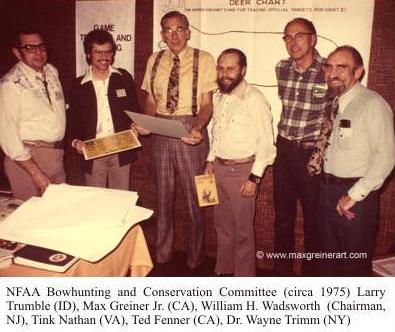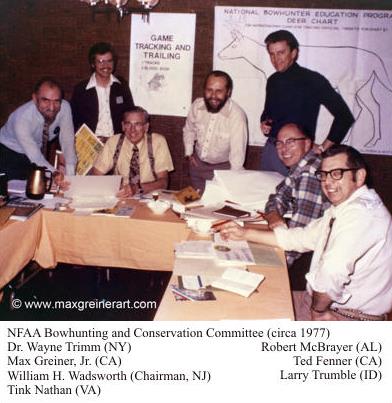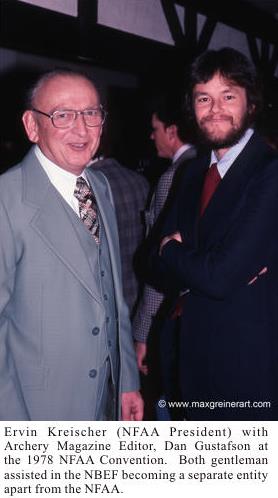Mission
The National Bowhunter Education Foundation offers instructional content and tools for bowhunter education classes in the US. Helping bowhunters become safe and successful hunters and stewards of the sport are important NBEF missions. NBEF provides the bowhunter certification standards and class content that some states and certain circumstances require in order to bow hunt. NBEF provides instructor training and certification.
NBEF oversees the International Bowhunter Education Program, and works with the International Hunter Education Association and state agencies to coordinate a unified program. States may have additional requirements. European and other countries accept the NBEF (IBEP) certification and conduct classes.
NBEF also oversees the International Crossbow Education Program and works with state agencies responsible for crossbow education to develop comprehensive online crossbow safety courses that teach students important laws and regulations, game identification, and safe, responsible handling of crossbow equipment.
NBEF is a 501(c)3 corporation that isn’t a membership-based organization. Tax-deductible donations to support this non-profit are welcome.
Link
The History of the National Bowhunter Education Foundation
 Over 25 years ago a group of bowhunters met who were all members of the National Field Archery Association (NFAA). The purpose of the meeting was to discuss New Jersey native, Bill Wadsworth’s bowhunter education program. In 1969, Bill had written the course for the New York State Field Archers and Bowhunters Association and now wanted to take the program nationwide. After intense discussion, the group decided to follow Bill’s advice and help take the program nationwide. Originally, bowhunter education functioned as a separate committee of the NFAA. This committee was known as the Bowhunting and Conservation Committee of the NFAA. (See photos) Ten years later, bowhunter education was larger than any other single organization of bowhunters and with the blessing of the NFAA, the NBEF became a totally separate and independent 501 c 3 nonprofit foundation. On October 13, 1979, the first volunteer board of directors for the National Bowhunter Education Foundation met at the Land Between the Lakes Recreation Area in Kentucky. It was during that historic meeting that the group formally adopted the course (known as the International Bowhunter Education Program) which Bill had started 10 years earlier.
Over 25 years ago a group of bowhunters met who were all members of the National Field Archery Association (NFAA). The purpose of the meeting was to discuss New Jersey native, Bill Wadsworth’s bowhunter education program. In 1969, Bill had written the course for the New York State Field Archers and Bowhunters Association and now wanted to take the program nationwide. After intense discussion, the group decided to follow Bill’s advice and help take the program nationwide. Originally, bowhunter education functioned as a separate committee of the NFAA. This committee was known as the Bowhunting and Conservation Committee of the NFAA. (See photos) Ten years later, bowhunter education was larger than any other single organization of bowhunters and with the blessing of the NFAA, the NBEF became a totally separate and independent 501 c 3 nonprofit foundation. On October 13, 1979, the first volunteer board of directors for the National Bowhunter Education Foundation met at the Land Between the Lakes Recreation Area in Kentucky. It was during that historic meeting that the group formally adopted the course (known as the International Bowhunter Education Program) which Bill had started 10 years earlier.
 Bill Wadsworth was a retired Boy Scout of America Executive and an avid bowhunter who felt deeply that education was the key to saving the sport of bowhunting. That belief remains the basis for the mission of the organization today. To quote the late Bill Wadsworth, “During those formative years (1969-1979), we learned, achieved, made mistakes, improved, and developed a program which is now second to none.” It soon became clear that bowhunter education was much more than teaching people to be more safe and more successful bowhunters. Clearly it became one of the major deterrents to the anti-hunter’s efforts to eliminate bowhunting. Much of the early years work was spent developing the basic course materials which included student and teacher manuals, special charts and illustrations, as well as the various teaching techniques such as blood trailing during the field day activities. Board meetings during the early years were long and tiring and required visionaries such as Dr. Dave Samuel, Earl Hoyt, Jim Jones, and Len Cardinale to create a program that would stand the test of time.
Bill Wadsworth was a retired Boy Scout of America Executive and an avid bowhunter who felt deeply that education was the key to saving the sport of bowhunting. That belief remains the basis for the mission of the organization today. To quote the late Bill Wadsworth, “During those formative years (1969-1979), we learned, achieved, made mistakes, improved, and developed a program which is now second to none.” It soon became clear that bowhunter education was much more than teaching people to be more safe and more successful bowhunters. Clearly it became one of the major deterrents to the anti-hunter’s efforts to eliminate bowhunting. Much of the early years work was spent developing the basic course materials which included student and teacher manuals, special charts and illustrations, as well as the various teaching techniques such as blood trailing during the field day activities. Board meetings during the early years were long and tiring and required visionaries such as Dr. Dave Samuel, Earl Hoyt, Jim Jones, and Len Cardinale to create a program that would stand the test of time.
When you look to the health of the NBEF today, it is hard to imagine a time when the archery industry gave little encouragement to the organization. However, as the program evolved and attracted more industry involvement with individuals such as Jim Dougherty, M.R.James, and Al Henderson, the program became the accepted curriculum and the program became a tool used by every state (and internationally) to enhance and perpetuate bowhunting. Reciprocity of the program from state to state and even country to country proved to be another unifying factor and measure of its value to industry as well as the state wildlife agencies.
In those early years of growth, the relationship between the NBEF and the North American Hunter Safety Coordinators (as the International Hunter Education Association was known at that time) proved to be key. Bowhunter education would not have survived without the support of the state hunter ed administrators. Enter Bill Wadsworth and Jim Jones. Jim worked for the U.S. Fish and Wildlife Service and served on the NBEF board. Jim and Bill spent countless hours with state hunter ed personnel building strong relationships that remain today.
It was also during this time that the hunter ed administrators asked the NBEF to write an “Introduction to Bowhunting”. This was a one or two hour educational package to be used in all firearm safety classes. Many of the NBEF instructors helped by teaching this portion of the firearm education program throughout the country. Some bowhunters felt this would lead state hunter education administers to eliminate the NBEF course as they felt the administrators who didn’t know the intricacies of bowhunting might feel that two hours of training would suffice for bowhunters and eliminate the need for the regular bowhunter ed course. But actually, the opposite occurred. Putting a small amount of bowhunter education into the gun program, only reinforced the need for more bowhunter education to many administrators. This was just another factor that led to continued acceptance of the program.
 1972-1982
1972-1982
In the late ‘70’s and early ‘80’s, the NBEF moved into an Educational Training Center at the Land Between the Lakes. Board meetings were held there, as was the first meeting of state coordinators. During this time the demand for courses was growing so the board found it essential to start bringing the state coordinators together. In this pivotal three year period, 64 instructor workshops took place, the basic student manual went into its 10th printing, 20 states and provinces placed their names and logos on the cover of the student manual, and the NBEF published a Bowhunter Instructor Training Manual as well as an important set of eight educational deer targets. The NBEF wrote “The Fundamentals of Archery and Bowhunting” for the National Association of Hunter Safety Coordinators and also developed and presented innovative teaching techniques to firearms instructors in many states. As a measure of the program’s growth during this time, New York reached a milestone of 115,000 trained students.
The program was also gaining momentum in Canada. Bowhunter education became mandatory in Nova Scotia, and instructor courses were held in Manitoba, Saskatchewan, Quebec, and Alberta. In addition, the NBEF approved its now long-standing policy of voluntary/required bowhunter education, which also helped to move the program forward. Basically, the NBEF decided to not push for mandatory education which was seen by some to be an obstacle to recruiting more bowhunters. Instead, the NBEF focused on making the program more universally available.
Early boards were much larger than today’s board. In part this was due to the diverse need to hear from the many different segments of the industry and bowhunting community as the program was being formed. However, similarities still exist between the first board and today’s board. The 1981 board had archery industry representation, several state and provincial hunter ed administrators, wildlife biologists, archery instructors, educators, and everyday bowhunters who were interested in the future of bowhunting. Today’s board also has archery industry representation, hunter ed administrators, wildlife biologists, educators, and bowhunters interested in the future of bowhunting. One current board member, Dr. Wayne Trimm was on the committee that helped Bill Wadsworth begin the program in 1969. Dr. Trimm’s artwork and expertise continues to have a strong influence on the organization.
Today’s NBEF
In an effort to identify needs and to begin a renewed focus for the NBEF, the board of directors and regional coordinators held a two day “Pathfinder Session” in conjunction with their annual board meeting in July 2004. During strategic planning, the board targeted several subject areas that will be use current NBEF strengths while meeting the challenges faced by bowhunting today. These include expanding baseline data on instructors, courses, and graduates. Also expanding the data to include reports as they relate to graduates vs. non-graduates of bowhunter education. It was also decided to improve materials and product offerings and general services based on identified customer needs. The new student manual called “Today’s Bowhunter” is an example of improving materials with more material revisions to come in 2005. The group also decided to target retention of existing bowhunters by developing new programs through high interest, advanced classes or mentoring type curriculum.
Note: This piece of informative writing was reprinted in part from an article written by Dr. Dave Samuel which appeared in the December 2004 “Bowhunter” magazine. Dr. Dave Samuel served on the NFAA’s Bowhunting and Conservation Committee, which administered the first bowhunter education program from 1974-1979. ‘Dr. Dave’ later served on the NBEF board from ’79-’94, including four years as president. And, in 1993, the NBEF honored him with the William H. Wadsworth Award for his efforts.
Photos are the courtesy of Max Greiner Jr., P.O. Box 290552, Kerrville, TX 78029-0552
